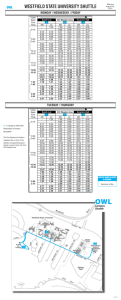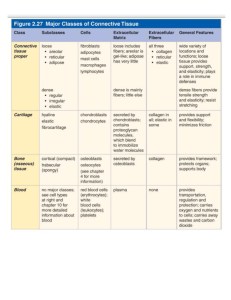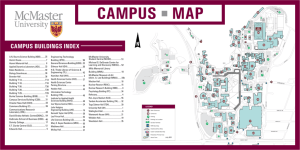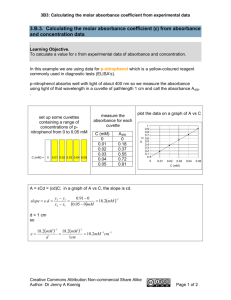click - Chemsheets
advertisement
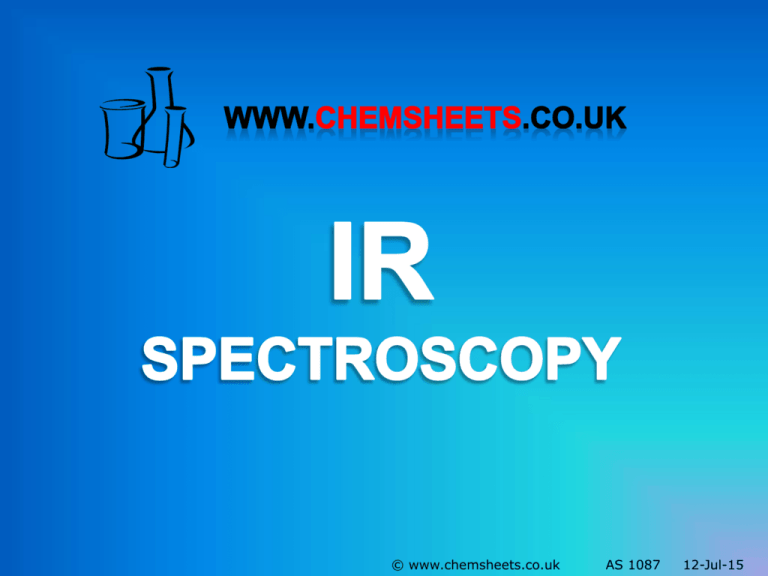
© www.chemsheets.co.uk AS 1087 12-Jul-15 Electromagnetic spectrum • Light is one form of electromagnetic radiation. • Light is only a very small part of the electromagnetic spectrum. • Electromagnetic waves consist of electric and magnetic fields which are perpendicular to each other and to the direction of travel of the wave. • The electric and magnetic fields vibrate at the same frequency as each other. Atoms, molecules and ions can absorb (or emit) electromagnetic radiation of specific frequencies, and this can be used to identify them. Electromagnetic radiation absorbed What the energy is used for Spectroscopy technique Ultra-violet / visible Movement of electrons to higher energy levels Ultra-violet / visible spectroscopy Infra-red To vibrate bonds Infra-red spectroscopy Microwaves To rotate molecules Microwave spectroscopy Radio waves To change nuclear spin NMR spectroscopy © www.chemsheets.co.uk AS 1087 12-Jul-15 Bond vibrations • All bonds vibrate at a characteristic frequency. • There are different types of vibration. Symmetric stretch Assymmetric stretch Bending • The frequency depends on the mass of the atoms in the bond, the bond strength, and the type of vibration. • The frequencies at which they vibrate are in the infra-red region of the electromagnetic spectrum. IR Spectra • If IR light is passed through the compound, it will absorb some or all of the light at the frequencies at which its bonds vibrate. • Wavenumbers (cm-1) are used as a measure of the wavelength or frequency of the absorption. Wavenumber = 1 wavelength (cm) • IR light absorbed is in the range 4000 – 400 cm-1. • Above 1500 cm-1 is used to identify functional groups. • Below 1500 cm-1 is used for fingerprinting. © www.chemsheets.co.uk AS 1087 12-Jul-15 Fingerprinting -1 (below 1500 cm ) • Complicated and contains many signals – picking out functional group signals difficult. • This part of the spectrum is unique for every compound, and so can be used as a "fingerprint". • This region can also be used to check if a compound is pure. © www.chemsheets.co.uk AS 1087 12-Jul-15 CH2 C CH2 CH3 CH3 CH3 C CH3 CH CH3 Functional Groups -1 (above 1500 cm ) © www.chemsheets.co.uk AS 1087 12-Jul-15 C=C 1620-1680 cm-1 O-H (alcohol) 3230-3550 cm-1 O-H (acid) 2500-3000 cm-1 C=O 1680-1750 cm-1 4000 3000 2000 1500 © www.chemsheets.co.uk 1000 AS 1087 500 12-Jul-15 C=C hex-2-ene C=C cyclohexene Alcohol O-H propan-1-ol Alcohol O-H butan-2-ol Acid O-H C=O ethanoic acid Acid O-H C=O butanoic acid C=O propanone C=O ethyl ethanoate C=O butanal Identify the Functional Groups © www.chemsheets.co.uk AS 1087 12-Jul-15 Alcohol O-H C=O C=O acid O-H Alcohol O-H C=O alcohol O-H C=O C=C C=O acid O-H C=O C=C IR Problems 1 © www.chemsheets.co.uk AS 1087 12-Jul-15 P Q R S T U IR Problems 2 © www.chemsheets.co.uk AS 1087 12-Jul-15 propanoic acid, butanone, 2-methylbut-2-ene, 1-hydroxypropanone, butan-2-ol 1 propanoic acid propanoic acid, butanone, 2-methylbut-2-ene, 1-hydroxypropanone, butan-2-ol 2 butan-2-ol propanoic acid, butanone, 2-methylbut-2-ene, 1-hydroxypropanone, butan-2-ol 3 butanone propanoic acid, butanone, 2-methylbut-2-ene, 1-hydroxypropanone, butan-2-ol 4 1-hydroxypropanone propanoic acid, butanone, 2-methylbut-2-ene, 1-hydroxypropanone, butan-2-ol 5 2-methylbut-2-ene IR Problems 3 hex-2-ene butanal pentane butanoic acid methylpropan-1-ol propyl ethanoate 2-methylpentan-3-one nitrobenzene © www.chemsheets.co.uk AS 1087 12-Jul-15 95 90 85 80 75 70 65 %T 60 55 50 45 40 35 30 25 20 15 10 4 000 3 500 3 000 2 500 2 000 W ave num bers (c m-1 ) 1 500 1 000 5 00 95 90 85 80 75 70 65 %T 60 55 50 45 40 35 30 25 20 15 10 4 000 3 500 3 000 2 500 2 000 W ave num bers (c m-1 ) 1 500 1 000 5 00 95 90 85 80 75 70 65 %T 60 55 50 45 40 35 30 25 20 15 10 4 000 3 500 3 000 2 500 2 000 1 500 1 000 5 00 W ave num bers (c m-1 ) 95 90 85 80 75 70 65 %T 60 55 50 45 40 35 30 25 20 15 10 4 000 3 500 3 000 2 500 2 000 1 500 1 000 5 00 W ave num bers (c m-1 ) 95 90 85 80 75 70 65 %T 60 55 50 45 40 35 30 25 20 15 10 4 000 3 500 3 000 2 500 2 000 1 500 1 000 5 00 W ave num bers (c m-1 ) 95 90 85 80 75 70 65 %T 60 55 50 45 40 35 30 25 20 15 10 4 000 3 500 3 000 2 500 2 000 1 500 1 000 5 00 W ave num bers (c m-1 ) 95 90 85 80 75 70 65 %T 60 55 50 45 40 35 30 25 20 15 10 4 000 3 500 3 000 2 500 2 000 1 500 1 000 5 00 W ave num bers (c m-1 ) 95 90 85 80 75 70 65 %T 60 55 50 45 40 35 30 25 20 15 10 4 000 3 500 3 000 2 500 2 000 1 500 1 000 5 00 W ave num bers (c m-1 ) propyl ethanoate 95 90 85 80 75 70 65 %T 60 55 50 45 40 C=O 35 30 C-O 25 20 15 10 4 000 3 500 3 000 2 500 2 000 1 500 1 000 5 00 W ave num bers (c m-1 ) 2-methylpentan-3-one 95 90 85 80 75 70 65 %T 60 55 50 45 40 35 C=O 30 25 20 15 10 4 000 3 500 3 000 2 500 2 000 W ave num bers (c m-1 ) 1 500 1 000 5 00 CH3 methylpropan-1-ol CH3 CH CH2 OH 95 90 85 80 O-H 75 70 65 %T 60 55 50 45 40 35 30 25 20 15 10 4 000 3 500 3 000 2 500 2 000 1 500 1 000 5 00 W ave num bers (c m-1 ) nitrobenzene 95 90 85 80 75 70 65 %T 60 55 50 45 40 35 30 C-H 25 20 15 10 4 000 3 500 3 000 2 500 2 000 W ave num bers (c m-1 ) 1 500 1 000 5 00 pentane 95 90 85 80 75 70 65 %T 60 55 50 45 40 35 30 C-H 25 20 15 10 4 000 3 500 3 000 2 500 2 000 W ave num bers (c m-1 ) 1 500 1 000 5 00 butanal 95 90 85 80 75 70 65 %T 60 55 50 45 40 35 30 C-H 25 20 C=O 15 10 4 000 3 500 3 000 2 500 2 000 1 500 1 000 5 00 W ave num bers (c m-1 ) butanoic acid 95 90 85 80 75 70 65 O-H %T 60 55 50 45 40 35 30 25 20 15 10 4 000 3 500 3 000 2 500 2 000 W ave num bers (c m-1 ) 1 500 1 000 5 00 hex-2-ene 95 90 85 80 75 70 65 %T 60 55 50 45 C-H C-H 40 35 C=C 30 25 20 15 10 4 000 3 500 3 000 2 500 2 000 W ave num bers (c m-1 ) 1 500 1 000 5 00 IR Problems 4 © www.chemsheets.co.uk AS 1087 12-Jul-15 F 95 90 85 80 75 70 65 %T 60 55 50 45 40 35 30 25 20 15 10 4 000 3 500 3 000 2 500 2 000 W ave num bers (c m-1 ) 1 500 1 000 5 00 G 95 90 85 80 75 70 65 %T 60 55 50 45 40 35 30 25 20 15 10 4 000 3 500 3 000 2 500 2 000 W ave num bers (c m-1 ) 1 500 1 000 5 00 1 95 90 85 80 75 70 65 %T 60 55 50 45 40 35 30 25 20 15 10 4 000 3 500 3 000 2 500 2 000 W ave num bers (c m-1 ) 1 500 1 000 5 00 2 95 90 85 80 75 70 65 %T 60 55 50 45 40 35 30 25 20 15 10 4 000 3 500 3 000 2 500 2 000 W ave num bers (c m-1 ) 1 500 1 000 5 00 3 95 90 85 80 75 70 65 %T 60 55 50 45 40 35 30 25 20 15 10 4 000 3 500 3 000 2 500 2 000 W ave num bers (c m-1 ) 1 500 1 000 5 00 Most IR spectra are from the SBDS data base
